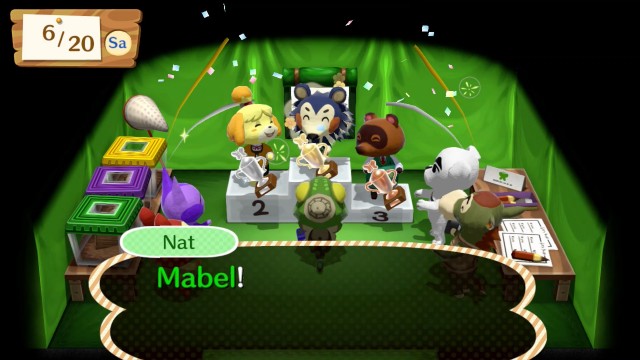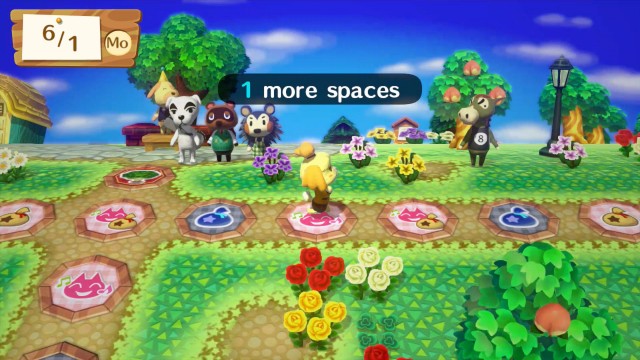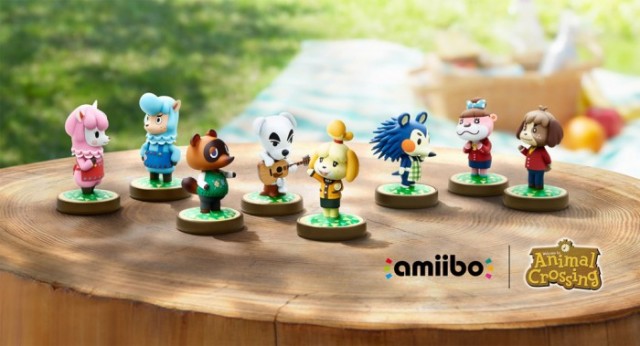Gorgeous presentation-- the Animal Crossing world looks great in HD; charming gameplay; micro cut scenes are wonderful; game modes are varied and fun
Slow unlock of content; Amiibo integration is overly aggressive; gameplay can become too sedate over extended play
Animal Crossing: Amiibo Festival is almost the antithesis of Mario Party. On the outside, the titles certainly look similar enough; a board game world, dice throwing, and minigames to be played by all. Despite sharing these elements, however, Amiibo Festival veers off into decidedly different territory that makes it unlike any other party game that I’ve played in the past. As opposed to being a frantic and over-the-top party title, Amiibo Festival attempts to be like a serene stroll through an Animal Crossing village, to mostly positive results. Fully embracing the world of Animal Crossing, Amiibo Festival is a disarming and endearing game that is stuffed with fun ideas but struggles with pacing and its Amiibo integration.
As the name makes apparent, Amiibo Festival revolves around the nominal toys-to-life figurines. These initial copies of the title come bundled with two Amiibo (Isabelle and her brother Digby), which is helpful because without at least one, there’s no way to play the game. When Amiibo Festival boots up, it immediately asks players to scan in the figure of their choice; it’s possible to play with up to four other people even with only a single Amiibo on-hand, though they’ll be limited to selecting a generic villager as their avatar. The game is played using just the GamePad, which is great for those who don’t have extra controllers laying around, but can become a little cumbersome when passed around repeatedly. Amiibo Festival’s board is set within an Animal Crossing village and each game takes place across the span of a month. Every turn marks the passing of a day, with the goal being to collect the most Happy Points.

Spaces can either bestow bells and/or Happy Points, or they can take them away. The second I started playing, the Animal Crossing influence became apparent. Every space on the board plays out an Animal Crossing vignette; little scenes that explain how the player earned bells, lost bells, what made them earn or lose a Happy Point, and so on. They’re adorable. It’s as cute and charming as one would expect from an Animal Crossing experience. One of the vignettes showed my character earning Happy Points because she set up wireless play on her 3DS with her friends, and they all shared their house designs with each other– awwww. Another scene depicted how my opponent lost some bells because she’d made a donation to the train station; because we all use it, so why not chip in?
If you love Animal Crossing and its nonchalant, meandering gameplay, it’s on full display here– for better and for worse. On the plus side of things, the sheer variety of scenes that can play is pretty astounding, which helps keep them from becoming tedious too quickly. The problem is, when playing Amiibo Festival for the first few times, this is the only gameplay on offer: rolling the dice, landing on a space, and watching the micro cinematic play out. Wash, rinse, and repeat. The scenes take seconds to unfurl, but without the addition of true minigames to engage in, the charm can begin to wear thin. Luckily, there are two additional features on the game board that help spice things up a little bit: Event Spaces and the Stalk Market.

Event spaces change over the course of the in-game month, with familiar characters like Redd and Katrina popping up and adding buffs such as additional spaces to move across the board or money-generating boosts. They amount to some hilarious cameos for Animal Crossing fans, as the appearances are in-character, and they’re also generously sprinkled across the playing field, so there’s always a good chance of landing on one. The Stalk Market will be immediately familiar to anyone who’s played an Animal Crossing game; Joan sells players turnips, which they can then try to make a profit off of by selling them at higher prices during the week. Each space on the board displays a price for the turnips, which can be lower or higher than what they were bought for, and players have to gamble whether or not it will be worth selling now versus waiting and hoping to land on a space with a better price.
Both Event Spaces and the Stalk Market lend a much needed layer of depth to Amiibo Festival’s primary game mode, but the title doesn’t stop there, as it also incorporates Fishing and Bug-Catching Tournaments, as well as seasonal events like Toy Day (which are determined by the month that the player chooses prior to a match). What can frustrate isn’t that there’s a lack of content in Amiibo Festival, but that it’s eked out in increments. Like Animal Crossing, the more Amiibo Festival is played, the more features are unlocked. New modes like Desert Island Escape, Quiz Show, and other minigames become available the deeper you go. The issue is that these unlocks come too slowly. The average round of Amiibo Festival can be manually capped off at 30 minutes, but that’s a minimum. On a given day, it’s hard to squeeze in a lot of matches for most people, meaning players can expect to spend a fair amount of time waiting to get their hands on the intrinsic content Amiibo Festival has to offer. Obviously, I don’t think any game should have everything open from the outset, but too much of what makes Amiibo Festival special is absent early on. It’s a bummer, for sure, but the title is so full of fresh ideas about the party game concept that I was willing to be patient with it, though admittedly I don’t know if everyone else will be able to do the same.

Though the game is upfront about the fact that it’s an Amiibo-driven experience, I can’t help but feel that the title is too much of a money pit for Nintendo’s toy and card line. I noted that Amiibo Festival comes packaged with two of the toys, but that’s only for a limited time (according to Nintendo), with the game eventually reverting to having a single Amiibo in the bundle. Sure, you can play the game with just one figurine, but that means being limited to having your pals play as pre-loaded variations of boy and girl Villagers. Which wouldn’t be too horrible, I suppose, until considering there’s a slight penalty for playing with one Amiibo; anyone playing as a Villager won’t get Happy Points just for rolling the dice like the Amiibo player does. Why the handicap? To get fans to dish out more cash on the toys and cards, I guess. Granted, it’s fun storing your supply of Happy Points to an Amiibo and using them to unlock new customization features, and the Amiibo Cards can be used to bring new animals to the game board, but there’s no denying that Nintendo has just a touch too much of this title hidden behind a not-so-invisible pay wall.
There’s plenty to see and do in Amiibo Festival, so long as players have the time to invest in unlocking it all. This isn’t a challenging title, but that’s fine because it’s not meant to be one; this is the Animal Crossing version of a party, meaning everyone can come, have fun, and soak in the game’s positive and uplifting attitude. Some fans will be irritated by the need to buy so many Amiibo products to get the most out of Amiibo Festival, which is disappointing. Nintendo’s previous efforts with the toys have been less demanding, so I guess it was only inevitable that the company would take a more aggressive approach with the line. If Amiibo Festival had more playable animal neighbors right out of the box, even if they weren’t the marquee characters like K.K. and Tom Nook, I’d be less agitated, but as it stands Nintendo made a mistake in leaning so heavily on the figurines and cards. It shouldn’t take multiple additional purchases to see and enjoy all the familiar characters who define Animal Crossing; it’s like playing a Zelda game where Link doesn’t show up until his Amiibo is purchased and scanned in later. Not cool. Despite this glaring shortcoming, Amiibo Festival is good, relaxed fun that will be perfect during the holidays and parties with friends.




 ShareThis
ShareThis





